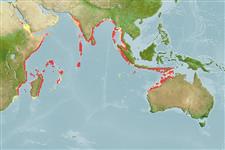Common names from other countries
Environment: milieu / climate zone / depth range / distribution range
Ökologie
seewasser; süßwasser; brackwasser benthopelagisch; katadrom (Ref. 51243). Tropical; 23°N - 33°S
Asia: Pakistan, India, Sri Lanka, Burma, and the East Indies. Reported from Nepal (Ref. 9496, 12045) and Bangladesh (Ref. 1479).
Size / Gewicht / Alter
Maturity: Lm ? range ? - ? cm
Max length : 200 cm TL Männchen/unbestimmt; (Ref. 85009); common length : 80.0 cm TL Männchen/unbestimmt; (Ref. 4832); max. veröff. Gewicht: 6.0 kg (Ref. 1479)
Rückenflossenweichstrahlen (insgesamt) : 250 - 305; Afterflossenweichstrahlen: 220 - 250; Wirbelzahl: 106 - 112. Body elongate, head conical, flattened dorsally. Mouth terminal, lips prominent, narrow bands of teeth on jaws, broad band on vomer.
Lives in freshwaters, but also occurs in estuaries and in the sea during early life and near maturity (Ref. 4832). Occurs in freshwater streams, pools and reservoirs and commonly found in mud substrates of tanks and in deep rock pools of rivers (Ref. 41236). Most common eel in Indian inland waters. There exists a good export market for both live elvers and eels. Highly prized as food fish because of its nutritional value. Fish mucous from live fish mixed with rice or wheat flour is used as medicine for arthritis (Ref. 44150).
Life cycle and mating behavior
Maturities | Fortpflanzung | Spawnings | Egg(s) | Fecundities | Larven
Talwar, P.K. and A.G. Jhingran, 1991. Inland fishes of India and adjacent countries. vol 1. A.A. Balkema, Rotterdam. i-liv + 1-541, 1 map (Ref. 4832)
IUCN Rote Liste Status (Ref. 130435)
CITES (Ref. 128078)
Not Evaluated
Bedrohung für Menschen
Harmless
Nutzung durch Menschen
Fischereien: kommerziell; Aquakultur: zukünftige nutzung; Sportfisch: ja
Tools
Zusatzinformationen
Download XML
Internet Quellen
Estimates based on models
Preferred temperature (Ref.
115969): 26.2 - 29.3, mean 28.3 (based on 292 cells).
Phylogenetic diversity index (Ref.
82804): PD
50 = 0.5000 [Uniqueness, from 0.5 = low to 2.0 = high].
Bayesian length-weight: a=0.00076 (0.00037 - 0.00155), b=3.17 (3.00 - 3.34), in cm Total Length, based on LWR estimates for this Genus-body shape (Ref.
93245).
Trophic level (Ref.
69278): 3.8 ±0.7 se; based on size and trophs of closest relatives
Widerstandsfähigkeit (Ref.
120179): sehr niedrig, Verdopplung der Population dauert mehr als 14 Jahre. (Preliminary K or Fecundity.).
Fishing Vulnerability (Ref.
59153): Very high vulnerability (90 of 100).
